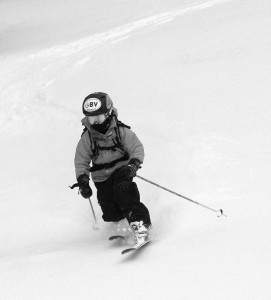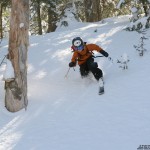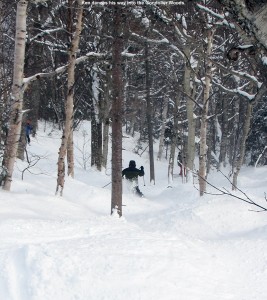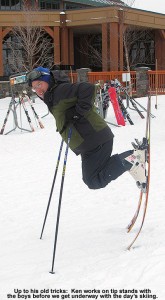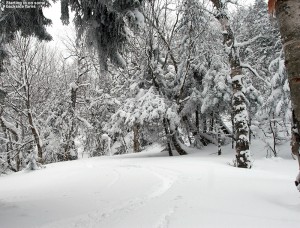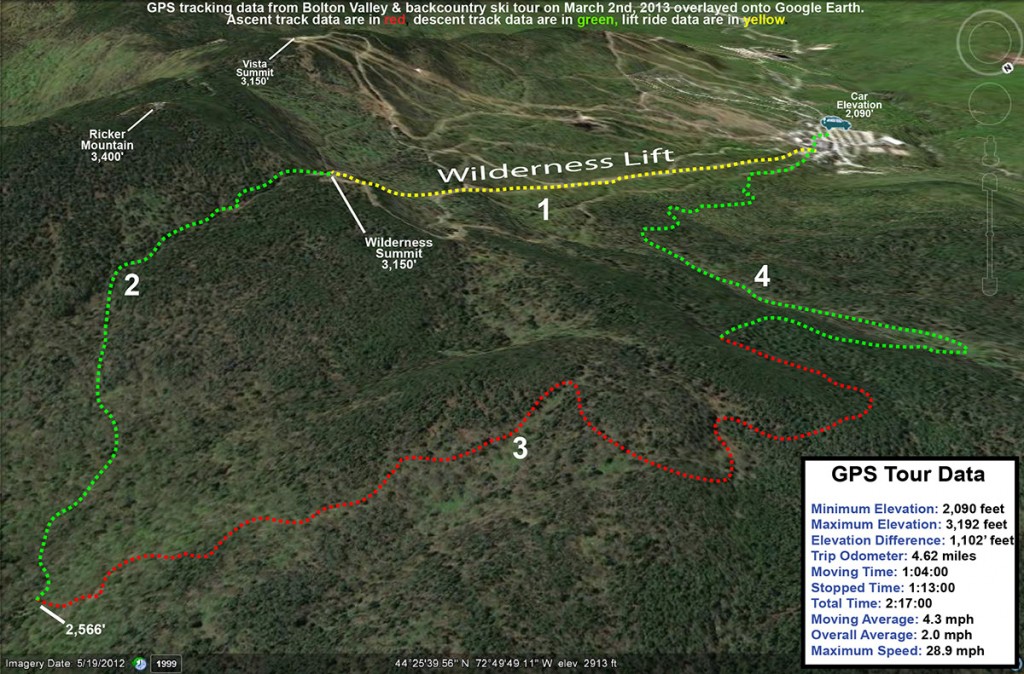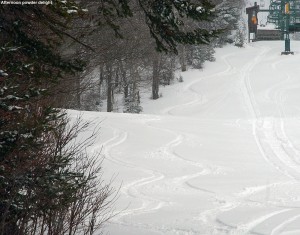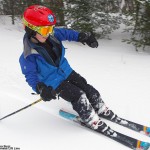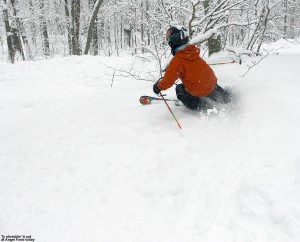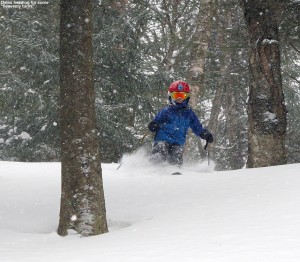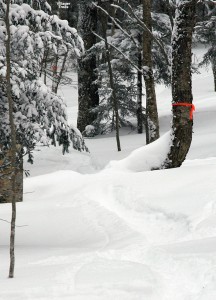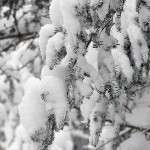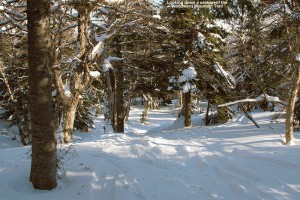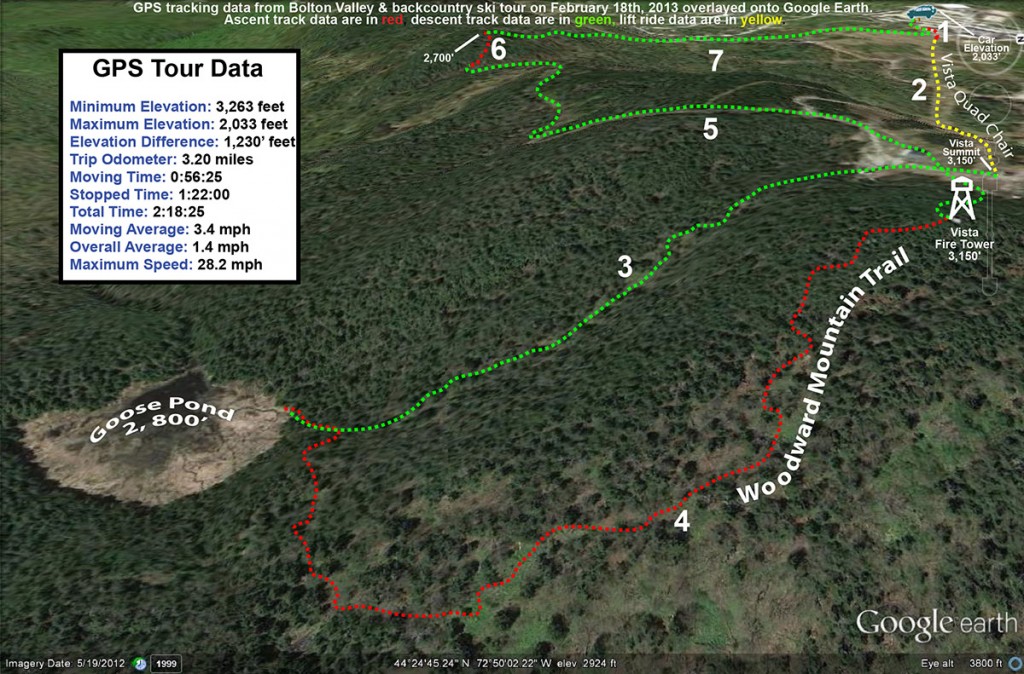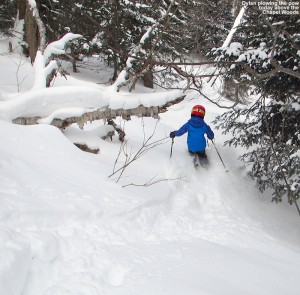
The temperatures are staying cold, the powder is staying dry, and we were off to Stowe this afternoon to check it out. Stowe reported similar snowfall numbers to Bolton Valley for the past couple of storms, and based on what we experienced yesterday, I knew that there was going to be some great powder skiing out there on parts of the mountain. The current conditions are just excellent for powder skiing on moderate angle terrain; the warmth from earlier in the week set up a smoothed subsurface to support the new snow that fell later in the week. As I tossed around ideas of where to bring our BJAMS ski group today, I eventually realized that the Chapel Glades and the other woods surrounding that area were going to be just what we needed. I haven’t brought any of the kids there that I can remember, nor had I been there much myself in the past few seasons, but it looked like it was time to change that.
Peering out from the car as we arrived at the mountain, it looked cold and windy at the Spruce Peak Base Area, and indeed it was. It wasn’t January cold, but it was on the cold side for March, with midday temperatures around 20 F and plenty of wind to add some extra bite. While we waited for the entire group to assemble, we did a quick run off the Alpine Double Chair, and as a prelude to the day, I brought Ty, Dylan, Luke, and Jack into some of the Upper Meadows Trees. It was a test to see just how good the powder skiing was going to be, and it was a perfect introduction. The pitch in there is somewhere in the light blue range, which was just right for the 6 to 8 inches of settled powder lying on the ground. There hadn’t been a single track in there before we entered, but after everyone in the group dove in after us to try their hand at the powder, it looked quite different. The whoops and shouts as people passed through made it pretty clear that we were going to have a lot of fun finding more of that terrain throughout the day. That section of trees has a tight exit, and you could certainly tell the more veteran tree skiers from those that were still learning the ropes, but everyone eventually made it out successfully. Farther below, on the open terrain above Meadows, we found very good chopped up powder with some fresh snow thrown in by the winds, so that was also encouraging with regard to overall conditions.
With Claire, Joe and Ethan, Ken and his family, and some additional family and friends of Ken’s,, our group numbered 16 as we headed over to Mt. Mansfield. There was no way we were going to hold that large a posse together, but we set our meeting point as the bottom of the Fourrunner Quad and knew that we’d all get there. The trip down Cliff Trail was OK, even if it felt a bit cramped with such a large group, but conditions really became icy once we got to Nosedive. I’m not sure if it’s the manmade snow or the traffic levels there, but if we hadn’t already been set on our course toward better snow, that experience would have done it. The highlight of that run was discovering the Liftline Trees that brought us all the way from Midway down to almost the base. I can’t believe how open those trees are, or that we haven’t been skiing them all season. They are going way up on our hit list as an alternative to skiing Lower Liftline. We hopped on the Fourrunner Quad, and at the summit I showed the group the top of the Bruce Trail since we’re contemplating a sidecountry trip in that area next week if conditions cooperate. We proceeded toward Ridge View and Sunrise, and I showed the group some of the Sunrise Trees above Toll Road. The powder was really good in there, especially as we worked our way over toward some of the less tracked areas. Dylan and I found lines with 8-12” inches of accumulation in there as we worked our way farthest to the skier’s right for a pit stop, and the turns were very impressive.
Below Toll Road we all dropped into the Chapel Glades and, they delivered just the kind of skiing that I’d expected. The main lines were fairly tracked, which is not surprising since they are an official glade on the map, but just a little venturing off to the sides revealed lots of untracked lines with a consistent 6-8” of powder. The pitches were just perfect for the snow we had. We regrouped at the Chapel, and as we passed along some of the Toll Road trees, we ogled the acres and acres of untracked snow that sat below us. We decided that we’d do another lap on the Mountain Triple, and we set our sights on a big run all the way down to the Toll House. As a bonus, we caught a lap through the half pipe and the terrain features on Standard – although a great part for some of us was the powder off to the sides more than the terrain features. Joe was having a blast with the skiing, and he commented on how he was quickly gaining confidence and an understanding of what was possible among the trees. It really is an eye opening experience for skiers that get past that tree skiing threshold, because they start to appreciate that they’ve got thousands of acres between the in bounds and sidecountry terrain of Mt. Mansfield and Spruce Peak. I started pointing out lines to Joe and Claire on our next lift ride, and it seemed like everywhere we looked, large expanses of open tree skiing terrain were just sitting there. Even though base depths haven’t really gone up too substantially over this past week, it’s as if a switch was flipped and lines hit some sort of threshold. That warming and base consolidation must have locked up some obstacles the previously might have been lurking in the soft snow.
We’d temporarily lost Ken and his family, but with a bit of cell phone help we managed to get back together for our next run. We traveled farther along Toll Road before dropping into the Chapel Glades, and I regained a perspective on just how large that complex of glades actually is. This time, we continued down into the Toll House Woods, and really got a long run through the powder. It’s over a mile down to the Toll House, and we couldn’t ski the woods the whole way, but I bet we were in there for close to half of it, with the Tollhouse trail also got us some great fresh snow. When folks asked me why nobody ever skied down there, I said it was because of the long, slow return back to the rest of the resort, but on days like this when the conditions fit the terrain just right, it’s certainly worth it.
After our long trip on the Toll House Lift, we collectively decided to call it a day, but a few of us hit one more glade in the Lullaby Lane Trees, and that was a fun discovery. This was definitely one of those days where you really start to gain an appreciation for the vastness and seemingly limitless ski options available at Stowe. Despite years of skiing there, I just keep finding entirely new areas to ski.
E and the boys and I went to the Whip for dinner on the way home, and met up with Claire and Luke in the dining room. The Whip is one of our favorite places because they’re open all day, and you can get great food there while other places are in between lunch and dinner. So if you have an early ski day at Stowe and finish in the mid afternoon, you can stop in at The Whip and get a great meal. It’s going to be interesting to see how things work out next weekend in terms of conditions, because we could be in for quite a snowy week if the forecast is correct.

